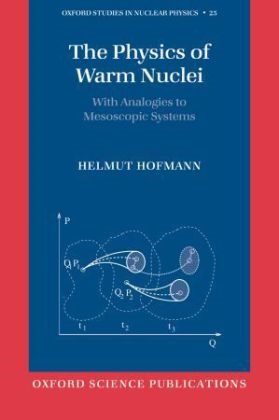Ulteriori informazioni
Zusatztext The book is considerably self-contained and presents existing models, theories and theoretical tools, from both nuclear physics and other fields, which are relevant to an understanding of the observed physical phenomena. Informationen zum Autor Professor Dr. Helmut Hofmann (retired) Department of Physics Technical University of MunichDiploma (Universität Heidelberg, 1968) Dr. rer.nat. (Universität Heidelberg, 1971) Dr. rer.nat. habil. (Technische Universität München, 1979) Privatdozent (Technische Universität München, 1993) apl Professor (Technische Universität München, 2001) Klappentext The book describes in detail modern developments in theories of small many body systems like nuclear complexes in accelerator experiments or metal clusters. To make the book self-contained, topics of general nature are included such as Equilibrium- and non-Equilibrium Thermodynamics, Linear Response Theory, and Functional Integrals. Zusammenfassung This book offers a comprehensive survey of basic elements of nuclear dynamics at low energies and discusses similarities to mesoscopic systems. It addresses systems with finite excitations of their internal degrees of freedom, so that their collective motion exhibits features typical for transport processes in small and isolated systems. The importance of quantum aspects is examined with respect to both the microscopic damping mechanism and the nature of the transport equations. The latter must account for the fact that the collective motion is self-sustained. This implies highly nonlinear couplings between internal and collective degrees of freedom --- different to assumptions made in treatments known in the literature. A critical discussion of the use of thermal concepts is presented. The book can be considered self-contained. It presents existing models, theories and theoretical tools, both from nuclear physics and other fields, which are relevant to an understanding of the observed physical phenomena. Inhaltsverzeichnis I BASIC ELEMENTS AND MODELS 1: Elementary concepts of nuclear physics 2: Nuclear matter as a Fermi liquid 3: Independent particles and quasi-particles in finite nuclei 4: From the shell model to the compound nucleus 5: Shell effects and Strutinsky renormalization 6: Average collective motion of small amplitude 7: Transport theory of nuclear collective motion II COMPLEX NUCLEAR SYSTEMS 8: The statistical model for the decay of excited nuclei 9: Pre-equilibrium reactions 10: Level densities and nuclear thermometry 11: Collective motion of large scale at finite thermal excitations 12: Dynamics of fission at finite temperature 13: Heavy ion collisions at low energies 14: Giant dipole excitations III MESOSCOPIC SYSTEMS 15: Metals and quantum wires 16: Metal clusters 17: Energy transfer to a system of independent Fermions IV THEORETICAL TOOLS 18: Elements of reaction theory 19: Density operators and Wigner functions 20: The Hartree-Fock method 21: Transport equations for the one-body density 22: Nuclear thermostatics 23: Linear response theory 24: Functional integrals 25: Properties of Langevin- and Fokker-Planck equations V AUXILIARY INFORMATION 26: Formal means 27: Natural units in nuclear physics References ...

